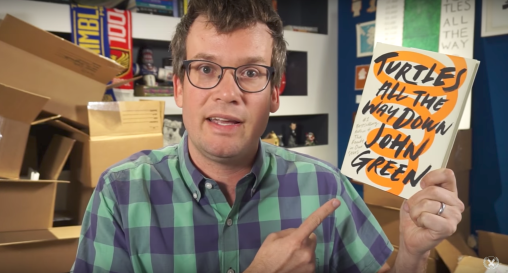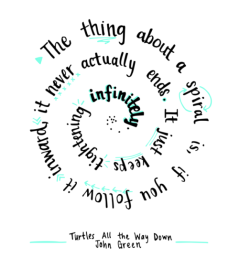With fugitive billionaires, six figure cash rewards and high school romances, the story begins an earnest mystery, with the sixteen year old protagonists OCD as an important subplot. Terrified that her identity is inseparable from her invasive, obsessive thoughts, Aza’s beautifully implemented inner turmoil is a lesson to every reader in mental illness and the unique struggles it presents to each individual. Her and her best friend Daisy set off on a charming and comical journey to finding said fugitive billionaire, and love and chaos ensues. As the story progresses, however, the plot itself seems to be almost subsidiary to the real story of Aza’s internal behaviour, functioning as an accessory to the characterisation of the narrator, rather than the other way around. Instead of promoting the popular rhetoric around mental health that reconciles illnesses as battles to be won, John Green paints a picture that instead suggests mental illness can be present and yet still the person in question can find ways to lead a fulfilling life.

His band of characters, as is delightfully typical of Green’s work, are unabashedly quirky and at times precociously intellectual, their conversations seamlessly morphing from Star Wars fan fiction to Darwinian theory to constellations (stars are a motif that come up again and again in Green’s work, and they work no less poetically here). Aza’s friends provide more lighthearted interludes to the story and her life, but also illustrate how alienating Aza’s intrusive thoughts can be, as she finds herself disconnected from her friends as well as her own self. Each of Green’s characters are as charming and convincing as the next.
 Popular media has become increasingly interested in the portrayal of mental health issues, but three dimensional OCD characters, however, seem harder to find. Instead, the portrayal of obsessive compulsive roles is reduced to cheap tropes of germaphobes who can’t stop washing their hands, like Glee’s Emma Pilsbury. Green, an OCD sufferer himself, presents the disorder as much more nuanced and real, giving time to all the ins and outs and ups and downs of Aza’s “thought spirals”. Aza’s true anguish lies within these spirals- the spiral tightens infinitely in on itself as she struggles to control the invasive thoughts that swarm her mind. You don’t have to be an OCD sufferer yourself to be moved to tears by her relentless struggle against herself.
Popular media has become increasingly interested in the portrayal of mental health issues, but three dimensional OCD characters, however, seem harder to find. Instead, the portrayal of obsessive compulsive roles is reduced to cheap tropes of germaphobes who can’t stop washing their hands, like Glee’s Emma Pilsbury. Green, an OCD sufferer himself, presents the disorder as much more nuanced and real, giving time to all the ins and outs and ups and downs of Aza’s “thought spirals”. Aza’s true anguish lies within these spirals- the spiral tightens infinitely in on itself as she struggles to control the invasive thoughts that swarm her mind. You don’t have to be an OCD sufferer yourself to be moved to tears by her relentless struggle against herself.
And what would a John Green novel be without profound existential questioning and realisations about love, “It’s a weird phrase in English, in love, like it’s a sea you drown in or a town you live in. You don’t get to be in anything else—in friendship or in anger or in hope. All you can be in is love.”, life, “life is a series of choices between wonders.” and self, “I is the hardest word to define.” On top of being beautifully quotable, Green brings to life the mental health discourse in a way that is rarely seen. Aza and her therapist speak about the problem with approaching pain, that it is often something beyond normal language- we verbalise pain with metaphor and poetry, instead of concrete terms. John Green spoke about how he wanted to find some way around this, and he does so wonderfully. He does not alienate the reader who knows very little about OCD, creating such a vivid picture of the debilitating affliction that when Aza tries to offer an explanation to her best friend, the reader feels equally as frustrated when she cannot come up with the right words. We align ourselves with Aza whether or not we have any first hand experience of her illness.
 “Your now is not your forever“, is the comforting message that comes through all of the chaos. It is in these words that we feel the authorial presence most deeply. The book is narrated by a sixteen year old high-schooler learning to cope with a destructive mental illness, and John Green was once a sixteen year old high-schooler doing the exact same thing. Refreshingly, Green doesn’t buy into happy endings (as his narrator put it, “The problem with happy endings is that they’re either not really happy, or not really endings, you know? In real life, some things get better and some things get worse. And then eventually you die.“), and instead brings us something much more moving- a realistic conclusion that promises possibility.
“Your now is not your forever“, is the comforting message that comes through all of the chaos. It is in these words that we feel the authorial presence most deeply. The book is narrated by a sixteen year old high-schooler learning to cope with a destructive mental illness, and John Green was once a sixteen year old high-schooler doing the exact same thing. Refreshingly, Green doesn’t buy into happy endings (as his narrator put it, “The problem with happy endings is that they’re either not really happy, or not really endings, you know? In real life, some things get better and some things get worse. And then eventually you die.“), and instead brings us something much more moving- a realistic conclusion that promises possibility.
I am completely obsessed with the way John Green writes and would pay to read his shopping list (as a previous character of his also wished to do for their favourite author), but this works too. I cannot recommend Turtles All the Way Down highly enough.

Loved your review, Megan! I have just finished this book and I will definitely re-read some parts!
LikeLike
thanks so much! Glad you enjoyed it too
LikeLike